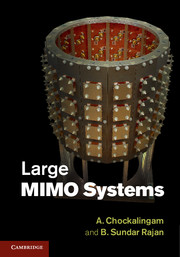Book contents
- Frontmatter
- Dedication
- Contents
- Preface
- Acknowledgments
- Abbreviations
- Notation
- 1 Introduction
- 2 Large MIMO systems
- 3 MIMO encoding
- 4 MIMO detection
- 5 Detection based on local search
- 6 Detection based on probabilistic data association (PDA)
- 7 Detection/decoding based on message passing on graphical models
- 8 Detection based on MCMC techniques
- 9 Channel estimation in large MIMO systems
- 10 Precoding in large MIMO systems
- 11 MIMO channel models
- 12 Large MIMO testbeds
- Author index
- Subject index
- References
8 - Detection based on MCMC techniques
Published online by Cambridge University Press: 18 December 2013
- Frontmatter
- Dedication
- Contents
- Preface
- Acknowledgments
- Abbreviations
- Notation
- 1 Introduction
- 2 Large MIMO systems
- 3 MIMO encoding
- 4 MIMO detection
- 5 Detection based on local search
- 6 Detection based on probabilistic data association (PDA)
- 7 Detection/decoding based on message passing on graphical models
- 8 Detection based on MCMC techniques
- 9 Channel estimation in large MIMO systems
- 10 Precoding in large MIMO systems
- 11 MIMO channel models
- 12 Large MIMO testbeds
- Author index
- Subject index
- References
Summary
In large systems where the physical laws governing system behavior are inherently probabilistic and complicated, traditional methods of obtaining closed-form analytic solutions may not be adequate for the level of detailed study needed. In such situations, one could simulate the behavior of the system in order to estimate the desired solution. This approach of using randomized simulations on computers, which came to be called the Monte Carlo methods, is powerful, elegant, flexible, and easy to implement. From the early days of their application in simulating neutron diffusion evolution in fissionable material in the late 1940s, Monte Carlo methods have found application in almost every discipline of science and engineering. Central to the Monte Carlo approach is the generation of a series of random numbers, often a sequence of numbers between 0 and 1 sampled from a uniform distribution, or, in several other instances, a sequence of random numbers sampled from other standard distributions (e.g., the normal distribution) or from more general probability distributions that arise in physical models. More sophisticated techniques are needed for sampling from more general distributions, one such technique being acceptance–rejection sampling. These techniques, however, are not well suited for sampling large-dimensional probability distributions. This situation can be alleviated through the use of Markov chains, in which case the approach is referred to as the Markov chain Monte Carlo (MCMC) method [1]. Typically, MCMC methods refer to a collection of related algorithms, namely, the Metropolis–Hastings algorithm, simulated annealing, and Gibbs sampling.
Information
- Type
- Chapter
- Information
- Large MIMO Systems , pp. 169 - 196Publisher: Cambridge University PressPrint publication year: 2014
